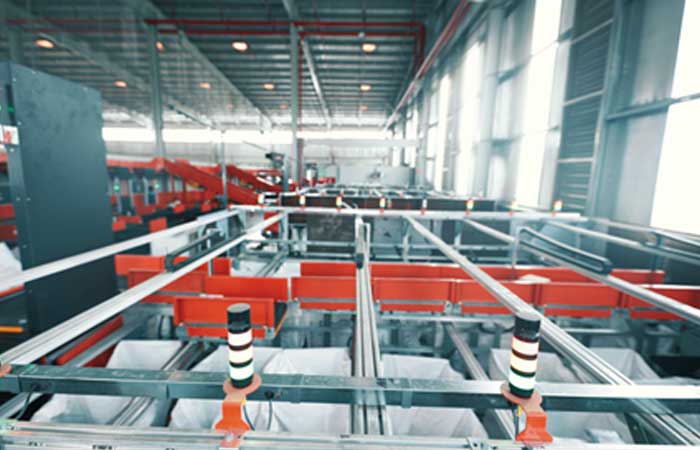
Why automation in intralogistics matters?
Nirav Doshi says, automation can make intralogistics in apparel transform companies to react instantaneously to changes in market conditions, customer satisfaction, and productivity.
The apparel industry is undergoing a significant transformation, driven by the need for greater efficiency, productivity, and innovation. Lying at the very heart of all this change and innovation is automation technology, reorganising how companies do their business internally. Several challenges are faced in the industry, which involves managing complex inventory systems and smoothing the process of order picking and shipment. Besides these, optimisation related to warehouse management is much sought after. Automation is addressing this head-on, offering customised solutions to meet the requirements of the company.
Automation technologies such as sorters and conveyors add to efficiency, keeping the levels of error at a minimum and contributing to a greater degree of accuracy within any warehouse or distribution center. Advanced data analytics and machine learning further go on in predicting demand, managing the optimum levels of inventory, and simplifying supply chains. This enables companies to respond on time to changes that may happen in the market. As a result, it reduces the risks associated with stockouts, overstocking, and missed opportunities. Automation technologies enable apparel companies to outperform others in the competitive landscape and foster growth toward the attainment of their objectives. Automation technologies also contribute to how companies cope with changing market conditions, consumer demands, and seasonal fluctuations. Companies can use automation to ensure better logistics operations, enhance supply chain flow, and improve overall efficiency and productivity levels.
Effective intralogistics solutions are vital for streamlining internal operations and aligning departments and functions within apparel companies. By implementing efficient inventory management, businesses can maintain optimal stock levels, minimise stockouts and overstocking, and enhance order-picking and shipping processes. This, in turn, enables faster and more precise order fulfillment, reducing lead times and improving customer satisfaction. Ultimately, well-designed intralogistics solutions drive operational efficiency, fueling competitiveness and growth.
Accordingly, effective intralogistics solutions improve warehouse management through which the companies can optimise storage capacity, reduce labor costs, increase the accuracy of inventory, and do many more things. In return, it would allow the firms to respond promptly to changes in market conditions, consumer demands, and seasonal fluctuations with a full-blown view of inventory levels and supply chain operations. This could further lead to making informed decisions for adjusting the production schedule and optimising inventory levels to meet changing demand.
It enables companies to improve their overall efficiency, productivity, and competitiveness. The automation of all the manual processes will reduce errors and enhance accuracy, which shall enable companies to focus on value addition in activities related to design, marketing, and customer service. Effective intralogistic solutions in the end translate into better customer satisfaction, increased loyalty, and repeat business, thereby driving growth and profitability in the apparel business.
Intralogistic solutions used within the apparel industry vary from very simple manual sorting and conveyor systems to fulfillment centers. However, these solutions have tended to bring about inefficiencies, errors, and increased labor centers costs to date. For instance, manual sorting is slow, considering the human factor where one line might go out of place and cause a fault; this impacts inventory accuracy and delays in fulfilling orders.
It can be noticed that conveyor systems, though an improvement over manual sorting, often are not as flexible to adapt to changeable production demands. In fulfillment adoption, is usually plagued by high labor costs, inaccuracy in inventory tracking, and no order processing is accomplished.
Adoption of more sophisticated and automated intra-logistics solutions will be the only way to maintain competitiveness in today’s fast-moving fashion world. Such solutions can optimise the way internal operations are conducted by minimising errors and improving efficiency. For example, an automated sortation system will have inventory sorted quickly and accurately, and an automated storage and retrieval system to optimise the warehouse space and cut labor costs.
Advanced fulfillment centers can utilise automation to simplify order processing, decrease shipping times, and at the same time, improve customer satisfaction. Such advanced solutions enable apparel firms to enhance their overall efficiency and trim down costs, thereby enhancing their competitive advantage in the market. The bottom line is that the adoption of advanced intralogistics solutions will be crucial for apparels to remain competitive and meet emerging customer demands.
Fundamentally, automation can make intralogistics in apparel transform companies to react instantaneously to changes in market conditions, customer satisfaction, and productivity. Through automation, such an apparel company will manage to outcompete any competition, ensure growth, and realise business goals. Automation would free companies to concentrate on innovation, product development, and customer engagement, leaving routine tasks to the machines.
Some of the intralogistics automation solutions for apparel firms include a range to help with varied needs. Automated sorting systems can sort inventory quickly and accurately, while conveyor systems move goods efficiently through the warehouse. Automation of a fulfillment center may be provided to enable smoother processing of orders, packing, and shipping.
Other automation solutions are involved in optimising warehouse space and reducing labor costs with AS/RS, or automated storage and retrieval systems. Automated picking systems, like pick-to-light and pick-to-voice, can be assisted to help improve order accuracy and efficiency. There are also automated packaging systems to optimise packaging materials and reduce packaging waste.
The automation solutions can be tailor-made for the precise needs of each firm and smoothly integrated with existing systems and workflows. For example, a company can integrate automation with its ERP, WMS, or even a transportation management system.
These options include modifying automation software, changing conveyor layouts, or integrating automation with existing manual processes. By providing the level of modification to automation solutions desired in order to satisfy the needs, an apparel company can fully maximise efficiency gains and cost-cutting for the greater satisfaction of customers. Besides, scalable automation solutions can grow with the company by scaling up or down depending on changing demands and evolutionary business needs.
In sum, intralogistics automation is one of the main factors to increase profitability for an apparel company. With automation solutions, companies can innovate in internal operations and perform at higher levels of productivity, efficiency, and accuracy. Automated sorters, conveyors, and fulfillers optimise inventory management, order picking, and shipping processes, hence enabling companies to respond promptly to fluctuating market conditions and customer demand.
Intralogistics automation means, among other things, a reduction in labor costs, minimisation of errors, and the improvement of workplace safety for companies. This smoothening of internal operations means that companies now have more time to pay attention to value-added activities: product design, marketing, and customer service activities because they drive growth and innovation.
Moreover, this automation enhances customer satisfaction due to the fact that orders will be correctly and timely processed. The outcome is increased loyalty, repetition in purchases, and finally, profitability. Nowadays, intralogistics automation in the fast-moving clothing industry is not a luxury but an obligation for those companies that intend to remain in the market.
Thus, automation solutions will grant apparel companies the competitive advantage that further leads to a business gaining growth and success. Since the industry is evolving, intralogistics automation shall be significant in the future of apparel production and distribution. The company that goes with automation for intralogistics will, no doubt, stay ahead of such an environment of dynamism. The companies lagging will eventually lose the battle.
About the author:

Nirav Doshi, the Founder and Managing Director of NIDO Machineries, is a forward-thinking entrepreneur in the machineries, automation, and robotics industry. With over a decade at the helm of the NIDO, he consistently demonstrates a commitment to excellence, innovation, and sustainable growth. Nirav is an alumnus of the esteemed University of Michigan, where he earned his Bachelor of Engineering (B.E.) degree with a focus on Industrial & Operations Engineering.



